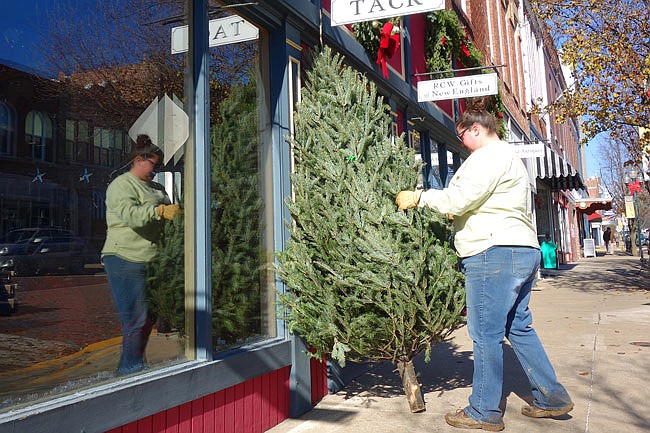In the olden days, people generally waited to deck the halls with boughs of holly until a few days before Christmas.
Many people today start decorating before the Thanksgiving leftovers are gone. For those whose decor includes live plants, that's quite a while to keep everything green and healthy.
Experts have advice for how to do exactly that.
Greenery
It's hard to deny the appeal of a fresh-cut, fragrant fir. That is, until it starts shedding needles on the floor and looking more like a fire hazard than a festive symbol.
Caitlin Wentworth, owner of RCW Gifts of New England in downtown Fulton, offers fresh trees and wreaths each winter. She sat out a selection of Fraser and "Fralsam" (a Fraser and Balsam hybrid) firs Wednesday morning.
Her father, Reuben Wentworth, trucks them all the way down from New Hampshire each year, and it's up to them to keep the greenery presentable until it goes to a new home.
Adequate watering is key, Wentworth said.
"The most important thing is to make a fresh cut on the tree, because otherwise the sap will seal off the pores," she said. "I recommend that you cut off the bottom 2 inches of the trunk."
The tree's base should be in water at all times, so check the tree stand's reservoir frequently. If the tree seems to be struggling to take up water, you can drill holes in the bottom of the trunk, Wentworth said. And, of course, never display a fresh tree next to a fireplace or heater.
It's harder to keep a wreath or garland watered. For those displayed inside, Wentworth recommends giving their needles a good coating of hairspray.
Outdoor wreaths and garlands can be misted with water on especially warm days.
"They last pretty well," Wentworth said. "Sometimes, we leave them up until January."
Poinsettias
Few things are sadder than a poinsettia in January.
University of Missouri Extension Horticulturist David Trinklein has advice for how to keep the plants perky.
"The care given a poinsettia following the holiday season largely will dictate whether or not the plant lives to see another Christmas," Trinklein said. "Most avid gardeners cannot bear the thought of discarding a healthy plant. Thus, this is the time of the year when many poinsettias find their way from a prominent location in the home to a sunny window."
Poinsettias thrive in the hot sunshine of Mexico. That means in the home, they want as much light as possible and not too much water. Place the poinsettia in a sunny window, preferably one that doesn't leak in cold air - the plant likes indoor temps above 65 degrees.
Water the soil until lightly moist (not soaking) all the way through when it's dry to the touch.
Trinklein said it's possible to keep a poinsettia alive year-round, and even prompt it to bloom the following year.
"If you are up to the challenge, then take good care of your plant throughout the winter by keeping it in a bright window," he said. "The plant probably will not make much active growth; therefore, fertilize it sparingly."
Once the danger of frost is past, place the plant's pot outside in a shady spot for a couple of days before moving it into full sun. The plant should grow rapidly. Trim it down to 6-8 inches around Labor Day and then move it back indoors.
Then comes the tricky part: forcing the plant to bloom. Beginning in September, pop the poinsettia into a closet every evening at sunset and remove it at sunrise. Once the plant's outermost leaves have gained significant color, you've succeeded in forcing the bloom and can stop the daily reshuffling.
"Even the best conditions indoors provide considerably less light than the greenhouse the plant was produced in originally," Trinklein noted. "However, it is worth the effort to see the phenomenon of leaves turning into colorful bracts at least one time by re-blooming a poinsettia."
Christmas cactus
While Christmas cactuses aren't as ubiquitous as poinsettias, they can be a festive and long-lasting addition to one's house. Their branches look like chains of holly leaves, and they produce large flowers in hot pink, red or white.
According to the Chicago Botanic Garden, unlike most cactuses you commonly encounter in stores, Christmas cactuses are rain forest dwellers. They like humidity and require more frequent watering than other cactuses.
Soak the soil whenever the top inch has dried out (then pour excess water out of the plant's dish). If the leaves seem dry, placing a cup of water beside the cactus will provide humidity as the water evaporates.
Christmas cactuses like sunlight, though the midday summer sun is too intense. Fertilize with a diluted houseplant fertilizer monthly from early spring to late summer. During the winter a window with northern exposure is preferable.
To trigger your plant to flower the next year, you'll need to start providing it with plenty of darkness every night, beginning about eight weeks before whenever you want it to blossom. Try putting it in a closet at sunset and removing it when you get up. After buds appear, start watering more frequently.
With a little love, Christmas cactuses can live for decades - even 30-plus years.

